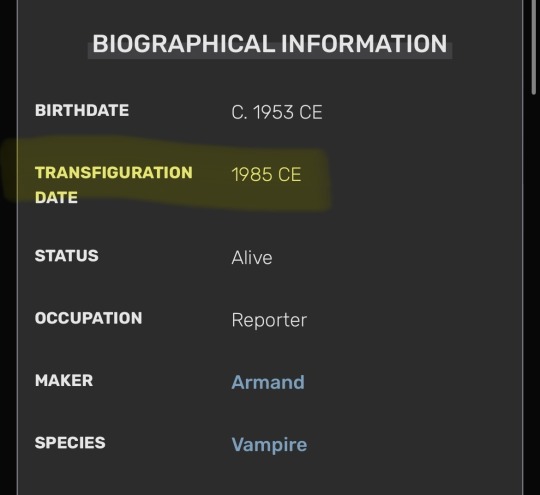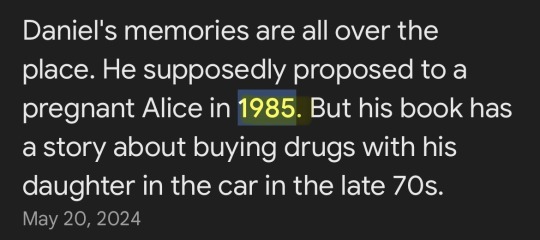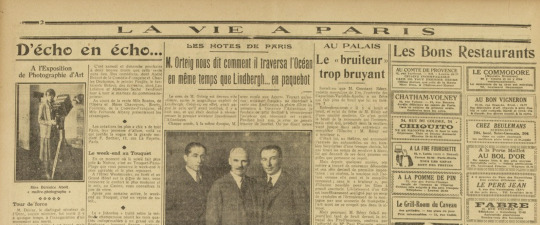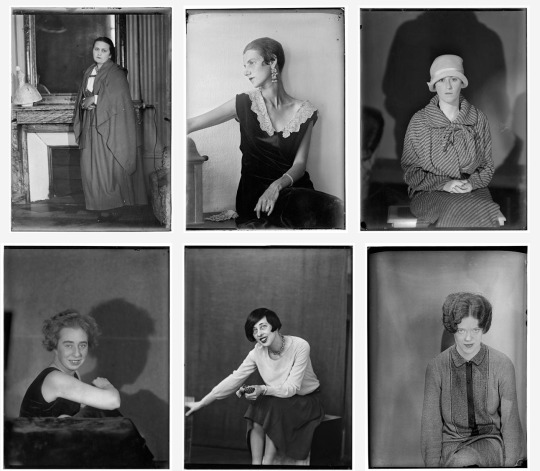#Servandoni
Explore tagged Tumblr posts
Photo

(vía Cúpula de la Capilla de la Virgen, Iglesia de St Sulpice – FOTOGRARTE)
#Cúpula#Capilla de la Virgen#Iglesia de San Sulpicio#París#Francia#Virgin's Chapel#Church of St. Sulpice#Paris#France#Baroque#Christophe Gamard#Servandoni#Louis Le Vau#Charles de Wailly#Lemoyne#Charles van Loo#En Español#In English#Fotografía#Arte#Photography#Art
1 note
·
View note
Text

Édouard Boubat, Spectacle de rue, Rue Servandoni, Paris, 1948
22 notes
·
View notes
Text






Likely the restaurant referenced in IWTV S1E2 by Daniel Malloy. May 2023
59 notes
·
View notes
Text


where alice stepped on a gum and made daniel scrape it off with a credit card (says louis) or a library card (says daniel)
#the corner of rue palatine and rue servandoni.......#i was too tired to go to the louvre today. but tomorrow!!!!
13 notes
·
View notes
Text

Rue Servandoni, Paris
Édouard Boubat, 1948
276 notes
·
View notes
Text
Also lil fun fact in s1… Louis reads a part of Daniel’s book where he’s talking about how recollection and memory can trick you: “I look at my daughter in the rear view mirror of my Buick sitting in her car seat… my editor tells me it’s 7 years before car seats become mandatory. My ex wife tells me I never had a Buick”

In the books Daniel is turned into a Vampire by Armand in 1985

In the show:

Louis: Alice is in her third trimester… she steps in gum on the corner of Rue Palatine and Servandoni.
Daniel: the old parlour trick…
Louis: she makes you scrape it off with a credit card..
Daniel: it’s not a credit card. I HAVE no credit, it’s a library card
Louis: She’s wearing that short purple dress you favor…
Daniel: I liked the way she lo- walked in it… she was CONFIDENT
Louis: You felt freer to hold her hand in Paris… *hint of sarcasm* I wonder why that is..
Daniel: hitting the garage door, Louis… all the crap… have at it
Louis: you worked SOOOO hard to get that table right in the corner so you could pull out the ring…
Daniel *scoffs*: the ring… that’s good..
Louis: just at the right moment to surprise her
Daniel: which I DID..
Louis: And what did she say when you finally asked her to marry you?
*Daniel has a flash of Armand in the 70s*
Louis: Danny. I’ll ask for a third time. What did ALICE say… when you finally asked her to marry you?
Armand *softly*: Louis perhaps we should…
Daniel *visibly upset* : She said no.
*Louis chuckles maliciously*
*long silence*
Armand *squirms on the couch and a sad uncomfortable expression comes over his face*: she wanted to say yes.
*Daniel’s eyes widen as he looks up at Armand*
Armand: she just didn’t trust you. You hadn’t given her a reason to.
Louis *still with a malicious tone*: do you want to know what she thinks of you now? IF she thinks of you now? *glances at Armand* we could do that
Armand: or we could simply return to the interview.
——
Season one Louis serves Daniel the dessert he had in Paris claiming he has a human meal once a week to hold onto the thread of humanity…
Daniel: this is the dessert I had after I proposed to my first wife… after I got my shit together. We were in Paris. Little cafe on the Rue Servandoni up the way from Saint Sulpice.
Louis: I know it. It’s a beautiful street.
Daniel *becoming nostalgic*: Alice…. Half of her eyebrow was blonde… like a mutt. She always dyed it back to brown…
Daniel *somewhat sadly*: I liked it when she left it alone….
*daniel closes his laptop stopping the recording of the interview*
67 notes
·
View notes
Text
Okay so
Why did Daniel "Paris sucks, their culture is bullshit" stay with Alice in Paris so damn long?
Him and her are at a brasserie, a typical French restaurant when she tells him she's pregnant. Now, a brasserie could be anywhere, true, but they are mostly seen in Paris and they could have used ANY term to indicate where they were, yet they chose that one.
And according to the memory Louis fishes out, she's in her third trimester when he proposed on the corner of Rue Palatine and Servandoni.
So, they stayed 9 or so months in a place Daniel strongly disliked, or they went there twice? (is it safe to fly when you're that pregnant? I honestly don't know)
Or is it a case of Daniel liking Paris before, and then being embittered by the place as well as a result of what happened?
26 notes
·
View notes
Text

Berenice Abbott at 18 rue Servandoni
The portrait on the cover of Julia Van Haaften's 2018 biography "Berenice Abbott: A Life in Photography" and at the top of Abbott's wiki page is by an unknown photographer. It was taken for the small newspaper Paris-Midi, published June 14, 1928. Keystone France agency, and now Getty owns the rights and incorrectly dates it as 1927, while Wikipedia dates it as "1930s."

At the time, her studio was at 18 rue Servandoni in Paris, we see the fireplace and door in the background in other portraits, such as the portrait of James Joyce's daughter, Lucia. There's a classic Atget at 15 rue Servandoni, but it's from 1903-4. Atget died in 1927 and Abbott, along with Julien Levy, saved his archive. By 1930 she was in New York City, where Walker Evans made his great portrait of her.
Van Haaften writes that in search of lower rent, Abbott moved to the rue Servandoni studio in early 1928. Abbott kept a clipping of the newspaper, but there's no further detail about the portrait session in the biography.
I was curious about the photographer of the portrait and found Getty has a handful of other frames from the same session that I'd never seen.

Most interesting of those frames is this contemplative shot showing the windows of her studio, maybe some photo chemicals on the table. A puff of smoke emanates from Abbott's cigarette in the same place where someone has left their fingerprint on the negative or print. There's a strong reflection or light leak in the top left corner of the frame. Van Haaften describes the rue Servandoni studio offering "beautiful north light."
Looking at the building on Google Earth, there is one north-facing spot that has the large windows similar to the 1928 portrait, seen in the center of the screen grab below.

Another detail Van Haaften mentions is that it took Abbott months to install electricity. An electric spotlight is on a tripod behind Abbott in the standing portrait. In the alternate angle you can see a not-to-code wire dangling.

So, who made these portraits? The Keystone France agency was an off-shoot of a popular stereoview company based in Meadville, Pennsylvania, hence "keystone." If you've ever flipped through old stereoviews at a vintage shop, you recognize this brand. The French agency was founded by Alexandre Garai in 1927 (whose brother Bertram started a related Keystone in London in 1914). The Met has one photograph by Alexandre Garai, taken in 1927. The jpeg is tiny, but indicates a modern perspective. While it's possible Garai is the photographer, his brother's ethos seems to have been to be the boss ... and never touch a camera.
The identity could be buried deep in Getty's London warehouse, which stores 80 million photographs and negatives. When these frames were scanned and metadata added to Getty in 2010-2016, if there was a name on the back of the prints, it probably would have been added then.
From the photos themselves, it's difficult to say if Abbott had a rapport or was familiar with the photographer: her default intensity is remarkably consistent her entire life, up until the last portrait of her in 1991.


(left, rue Servandoni 1929, right: Hank O'Neal, Berenice Abbott, Last Portrait, Monson, Maine July 17, 1991)
From the resolution, the depth of field on the lens, these are probably shot with a 4x5 or larger camera. It looks like the photographer shot the lens wide open, the camera in the standing portraits looks very much in focus, while Abbott's face looks slightly out of focus.
Two of the four frames have similar damage, could be a development problem, but could be mold later while in storage. Abbott's Paris portraits of the period were shot on glass (as much of Atget's body of work was), though by the late 1920s glass plates had mostly been replaced by film. Annoyingly, Getty is one of the best places online to see her Paris portraits, but the Steidl book is highly recommended. Seen together, you realize why Man Ray felt threatened, or at least annoyed, by his former assistant.

The photographer was either challenged or in a challenging environment. Abbott was often a withering critic, one can imagine a green photographer shows up to make portraits and encounters a prickly subject. With the seated portrait above, at first glance, I thought maybe the print has a piece torn out of the left side? Or is it a modern lamp intruding on the composition?
It's difficult to tell with the window portrait how much of it is a metering mistake or the potential development issue, but it looks several stops overexposed to be of use in publication of that time. Today, with our phone cameras taking three frames and digitally merging exposure, we can romanticize the top half of her body dissolving into the light is as the "magic of film."

I'm calling this the "last" frame of the session, based only on the fact that her pose and facial expression has shifted from intensity to a mix of boredom and exasperation. The photographer told her to sit on the day bed with tea and a book, "look relaxed," but she wants nothing to do with it.
31 notes
·
View notes
Text
"This is the dessert I had after I proposed to my first wife, after I got my shit together..."
Not on the rue Servandoni, but I mean... Close enough?
(sold in a Parisian bakery as a Pavlova)



74 notes
·
View notes
Note
Hi 👋🏻 . I was wondering where Paris Louis & Armand are gonna have sex in ? Does Armand have a special place where he lives there alone without the other theater vampires aren't there ? I remember him having a tower in the book & he had Lestat imprisoned there too . Will they probably go there to be alone & sleep together ?
Hey! 💕
I was just about to point out the fact that in the books, Armand still lives in the tower in which Lestat was turned, and he gifted it to Armand upon leaving Paris after the breakup with Nicki. 😬
The show might do something different, but I think we will see this infamous tower numerous times throughout S2 as it’s the scene of several iconic moments from both IWTV and TVL.
Also! Armand canonically buys and refurbishes a home in Paris for Louis located on the Saint-Germain-des-Prés. We might see that one as well since it’s very close to the Rue Servandoni near Saint-Sulpice, which is the street Daniel mentions in 1x02 during the dessert conversation.
#interview with the vampire#iwtv#interview with the vampire amc#iwtv amc#amc interview with the vampire#amc iwtv#iwtv 2022#louis de pointe du lac#armand#iwtv season 2#iwtv speculation
23 notes
·
View notes
Text


Plaque en hommage à : Olympe de Gouges
Type : Lieu de résidence
Adresse : 18 rue Servandoni, 75006 Paris, France
Date de pose : 1998 [inscrite]
Texte : OLYMPE DE GOUGES, 1748 - 1793, auteur de la Déclaration des Droits de la Femme et de la Citoyenne
Quelques précisions : Olympe de Gouges (1748-1793) est une écrivaine et femme politique française, et une figure majeure du féminisme dont elle est considérée comme une pionnière. Elle est ainsi particulièrement connue pour avoir publié, en 1791, la Déclaration des droits de la femme et de la citoyenne, texte majeur pour la promotion de l'égalité hommes-femmes, mais qui ne reçut guère de succès à sa publication en raison de l'indifférence des députés d'alors. Les droits des femmes ne furent toutefois pas son seul cheval de bataille : en effet, elle milita également pour l'abolition de l'esclavage, publiant par exemple en 1888 ses Réflexions sur les hommes nègres, dans lesquelles elle dénonce les méfaits de la colonisation et les préjugés raciaux. Elle est très engagée durant la Révolution française, exprimant nombre d'idées politiques et sociales et influençant autant que possible, hors des rangs des assemblées politiques dans lesquelles elle ne peut siéger à cause de son sexe, les différentes figures masculines de la Révolution comme Nicolas de Conforcet (également honoré par une plaque commémorative dans la même rue que celle-ci). Très critique de certains révolutionnaires comme Robespierre, elle est arrêtée en 1793 pour avoir évoqué dans un texte la possible instauration d'une monarchie constitutionnelle. Emprisonnée, elle tombe malade et est condamnée à mort : elle est guillotinée le 3 novembre 1793. Elle laisse un héritage considérable et est une des principales figures féminines de l'histoire de France, dont l’œuvre en faveur des droits des femmes est en particulier redécouverte après la Seconde Guerre mondiale. De très nombreux lieux de France portent son nom et les associations féministes se réclament encore aujourd'hui fréquemment de son inspiration. Une autre plaque commémorative en son honneur peut être trouvée dans le seizième arrondissement de Paris.
1 note
·
View note
Text

Édouard Boubat (Français, 1923-1999), Spectacle de rue, Rue Servandoni, Paris, 1948.
0 notes
Text
Holidays 5.2
Holidays
Astronomy Day
Ba Ba Ba Booo Day
Baby Day
Battle of Hogwarts Day (Harry Potter)
Bird L.A. Day (California)
Brothers and Sisters Day
Childhood Depression Awareness Day
Coarse Fishing Season begins (Medieval UK)
Day of Madrid (Spain)
Dos de Mayo Uprising Anniversary Day (Spain)
Fire Day
Flag Day (Poland)
Good Housekeeping Day
Holiday of the Region of Madrid (Spain)
International Harry Potter Day
International Loch Ness Monster Day
International Market Research Day
King James Bible Day
Mad Festival
National Babies Day
National Byron Day
National Curly Hair Day (UK)
National Day of Hiring
National Education Day (Indonesia)
National Fire Day
National Freeman-Sheldon Syndrome Awareness Day
National Life Insurance Day
National Play Your Ukulele Day
National Report Homeland Security Fraud Day
National Sandra Day
Natural Joy Day
Peasant's Day (Burma)
Placebo Day
Polish Diaspora and Poles Abroad Day
Robert's Rules of Order Day
Rowdy Friends Day
Sam Winchester Day (Supernatural)
Sappho Asteroid Day
Scurvy Awareness Day
Sibling Appreciation Day
Take a Baby to Lunch Day
Teachers’ Day (Bhutan, Iran)
Third Druk Gyalpo Day (Bhutan)
Trade Unions House Fire Anniversary (Ukraine)
Wallflower Day (French Republic)
World Bloggers Day
Food & Drink Celebrations
Green Tea Day (Japan)
National Matcha Day
National Truffle Day
World Tuna Day (UN)
1st Thursday in May
Idaho Gives Day (Idaho) [1st Thursday]
Kid Lit Art Postcard Day [1st Thursday]
Make-a-Book Day [Thursday of 1st Full Week]
Martin Z. Mollusk Day [1st Thursday]
Mom's Night Out [Thursday before Mother's Day]
National Children's Mental Health Awareness Day [Thursday of 1st Full Week]
National Day of Prayer [1st Thursday]
National Day of Reason [1st Thursday]
National Student Nurse Day [Thursday of 1st Full Week]
Thank a Dance Teacher [1st Thursday]
Thank a Youth Worker Day [1st Thursday]
Throwback Thursday [Every Thursday]
World Password Day [1st Thursday]
Weekly Holidays beginning May 2 (1st Week)
Children’s Book Week (thru 5.8)
Screen Free Week (thru 5.8)
Independence & Related Days
Hudson Bay Company (Founded; 1670)
Richensland (Declared; 2021) [unrecognized]
Festivals Beginning May 2, 2024
Earth Frequency Festival (Queensland, Australia) [thru 5.6]
Festival Accès Asie (Montreal, Canada) [thru 6.2]
LSR Wine Stroll (Chicago, Illinois)
Mushroom Festival (Richmond, Missouri) [thru 5.4]
Strawberry Festival (Cabot, Arkansas) [thru 5.4]
UK Asian Film Festival (London, UK) [thru 5.12]
Vinton County Wild Turkey Festival (McArthur, Ohio) [thru 5.5]
World Art Dubai (Dubai, UAE) [thru 5.5]
Feast Days
Ahudemmeh (Syriac Orthodox Church).
Alexandre Antigua (Artology)
Athanasius of Alexandria (a.k.a. Athanasius the Great; Western Christianity)
Blessing of the Deosil (a.k.a. Sunwise; Celtic Book of Days)
Boris I of Bulgaria (Bulgarian Orthodox Church)
Conrad of Seldenbüren (Christian; Saint)
Demosthenes (Positivist; Saint)
Eve of the Finding of the True Cross
Exsuperius and Zoe (Christian; Martyrs)
Feast of Osiris (who taught the Egyptians how to brew beer)
Feast of Ysahodhara (Consort of Buddha)
Fertility Festival featuring a Man wearing a hobbyhorse costume, a devil’s mask, and pointed hat (UK; Everyday Wicca)
Fiesta Dei Serpari (Cocullo, Italy)
Germanus of Normandy (Christian; Saint)
Giovanni Niccolò Servandoni (Artology)
Humane Day
Jerome K. Jerome (Writerism)
Junior (Muppetism)
Listen to Your Heart Day (Starza Pagan Book of Days)
Mafalda (Christian; Saint)
Media Ver I (Pagan)
Nina Hartley Day (Church of the SubGenius; Saint)
Ramen Day (Pastafarian)
Scurvy Awareness Day (Pastafarian)
Ultan (Christian; Saint)
Waldebert (Christian; Saint)
Wiborada (Christian; Martyr & Virgin)
Zoe (Christian; Saint)
Lucky & Unlucky Days
Lucky Day (Philippines) [25 of 71]
Tomobiki (友引 Japan) [Good luck all day, except at noon.]
Unlucky Day (Grafton’s Manual of 1565) [24 of 60]
Premieres
The Amazing Spider-Man 2 (Film; 2014)
Austin Powers: International Man of Mystery (Film; 1997)
The Awful Tooth (Noveltoons Cartoon; 1952)
Ballyhooey (Woody Woodpecker Cartoon; 1960)
Bulldog Drummond (Film; 1929)
The Cute Recruit (Phantasies Cartoon; 1941)
Daffy’s Southern Exposure (WB LT Cartoon; 1942)
Disintegration, by The Cure (Album; 1989)
A Dog’s Dream (Terrytoons Cartoon; 1941)
Emotional Intelligence, by Daniel Coleman (Book; 1996)
The Firm, by John Grisham (Novel; 1991)
The Holy Bible, King James Version (Religious Book; 1611)
Iron Man (Film; 2008)
I Wanna Dance with Somebody (Who Loves Me), by Whitney Houston (Song; 1987)
The Jack Benny Program (Radio Series; 1932)
Jo Jo Dancer, Your Life Is Calling (Film; 1986)
Let It Be Me (WB MM Cartoon; 1936)
Living With War, by Neil Young (Album; 2006)
Made of Honor (Film; 2008)
The Magician’s Nephew, by C.S. Lewis (Novel; 1955) [The Chronicles of Narnia #6]
Miracle on 34th Street (Film; 1947)
Money Heist (TV Series; 2017)
My Favorite Wife (Film; 1940)
No Ordinary Time, by Doris Kearns Goodwin (History Book; 1995)
The Odd Couple (Film; 1968)
The Old House (Happy Harmonies Cartoon; 1936)
Peter and the Wolf, by Sergei Prokofiev (Symphonic Fairy Tale; 1936)
Pontoffel Pock, Where Are You? (DePatie-Freleng Animated TV Special; 1980)
The Postman Always Rings Twice (Film; 1946)
Ragtime Romeo (Ub Iwerks Cartoon; 1931)
The Return of Dr. Fu Manchu (Film; 1930)
The Screwtape Letters, by C.S. Lewis (Novel; 1942)
Southern Fried Rabbit (WB LT Cartoon; 1953)
The Taming of the Shrew, by William Shakespeare (Play; 1594)
Tell Laura I Love Her, recorded by Ray Peterson (Song; 1960)
10,000 Days, by Tool (Album; 2006)
Triplanetary, by E.E. "Doc" Smith (Novel; 1948) [Lensman #1]
The Vanishing Duck (Tom & Jerry Cartoon; 1958)
The Wacky Rabbit (WB MM Cartoon; 1942)
Waitress (Film; 2007)
Wonderful Tonight, recorded by Eric Clapton (Song; 1977)
X2: X-Men United (Film; 2003)
Today’s Name Days
Athanasius, Boris, Siegmund (Austria)
Boriana, Boris, Borislav, Borislava (Bulgaria)
Atanazije, Boris (Croatia)
Zikmund (Czech Republic)
Athanasius (Denmark)
Maaja, Mai, Maia, Maie, Maiu (Estonia)
Viivi, Vuokko (Finland)
Boris, Zoé (France)
Boris, Siegmund, Zoé (Germany)
Avgerinos, Esperos, Matrona (Greece)
Zsigmond (Hungary)
Atanasio, Efisio (Italy)
Laris, Sigismunds, Visvaris, Zigmunds (Latvia)
Atanazas, Eidmantas, Meilė (Lithuania)
Åsa, Åse (Norway)
Afanazy, Anatol, Atanazy, Longin, Longina, Walenty, Walter, Witomir, Zygmunt (Poland)
Atanasie (Romania)
Tamara (Russia)
Žigmund (Slovakia)
Atanasio, Zoe (Spain)
Filip, Filippa (Sweden)
Bing, Zoe, Zoey, Zolita (USA)
Today is Also…
Day of Year: Day 123 of 2024; 243 days remaining in the year
ISO: Day 4 of week 18 of 2024
Celtic Tree Calendar: Saille (Willow) [Day 19 of 28]
Chinese: Month 3 (Wu-Chen), Day 24 (Bing-Yin)
Chinese Year of the: Dragon 4722 (until January 29, 2025) [Wu-Chen]
Hebrew: 24 Nisan 5784
Islamic: 23 Shawwal 1445
J Cal: 3 Magenta; Threesday [23 of 30]
Julian: 19 April 2024
Moon: 37%: Waning Crescent
Positivist: 11 Caesar (5th Month) [Ptolemy Lagus]
Runic Half Month: Lagu (Flowing Water) [Day 8 of 15]
Season: Spring (Day 45 of 92)
Week: 1st Week of May
Zodiac: Taurus (Day 13 of 31)
0 notes
Text
Holidays 5.2
Holidays
Astronomy Day
Ba Ba Ba Booo Day
Baby Day
Battle of Hogwarts Day (Harry Potter)
Bird L.A. Day (California)
Brothers and Sisters Day
Childhood Depression Awareness Day
Coarse Fishing Season begins (Medieval UK)
Day of Madrid (Spain)
Dos de Mayo Uprising Anniversary Day (Spain)
Fire Day
Flag Day (Poland)
Good Housekeeping Day
Holiday of the Region of Madrid (Spain)
International Harry Potter Day
International Loch Ness Monster Day
International Market Research Day
King James Bible Day
Mad Festival
National Babies Day
National Byron Day
National Curly Hair Day (UK)
National Day of Hiring
National Education Day (Indonesia)
National Fire Day
National Freeman-Sheldon Syndrome Awareness Day
National Life Insurance Day
National Play Your Ukulele Day
National Report Homeland Security Fraud Day
National Sandra Day
Natural Joy Day
Peasant's Day (Burma)
Placebo Day
Polish Diaspora and Poles Abroad Day
Robert's Rules of Order Day
Rowdy Friends Day
Sam Winchester Day (Supernatural)
Sappho Asteroid Day
Scurvy Awareness Day
Sibling Appreciation Day
Take a Baby to Lunch Day
Teachers’ Day (Bhutan, Iran)
Third Druk Gyalpo Day (Bhutan)
Trade Unions House Fire Anniversary (Ukraine)
Wallflower Day (French Republic)
World Bloggers Day
Food & Drink Celebrations
Green Tea Day (Japan)
National Matcha Day
National Truffle Day
World Tuna Day (UN)
1st Thursday in May
Idaho Gives Day (Idaho) [1st Thursday]
Kid Lit Art Postcard Day [1st Thursday]
Make-a-Book Day [Thursday of 1st Full Week]
Martin Z. Mollusk Day [1st Thursday]
Mom's Night Out [Thursday before Mother's Day]
National Children's Mental Health Awareness Day [Thursday of 1st Full Week]
National Day of Prayer [1st Thursday]
National Day of Reason [1st Thursday]
National Student Nurse Day [Thursday of 1st Full Week]
Thank a Dance Teacher [1st Thursday]
Thank a Youth Worker Day [1st Thursday]
Throwback Thursday [Every Thursday]
World Password Day [1st Thursday]
Weekly Holidays beginning May 2 (1st Week)
Children’s Book Week (thru 5.8)
Screen Free Week (thru 5.8)
Independence & Related Days
Hudson Bay Company (Founded; 1670)
Richensland (Declared; 2021) [unrecognized]
Festivals Beginning May 2, 2024
Earth Frequency Festival (Queensland, Australia) [thru 5.6]
Festival Accès Asie (Montreal, Canada) [thru 6.2]
LSR Wine Stroll (Chicago, Illinois)
Mushroom Festival (Richmond, Missouri) [thru 5.4]
Strawberry Festival (Cabot, Arkansas) [thru 5.4]
UK Asian Film Festival (London, UK) [thru 5.12]
Vinton County Wild Turkey Festival (McArthur, Ohio) [thru 5.5]
World Art Dubai (Dubai, UAE) [thru 5.5]
Feast Days
Ahudemmeh (Syriac Orthodox Church).
Alexandre Antigua (Artology)
Athanasius of Alexandria (a.k.a. Athanasius the Great; Western Christianity)
Blessing of the Deosil (a.k.a. Sunwise; Celtic Book of Days)
Boris I of Bulgaria (Bulgarian Orthodox Church)
Conrad of Seldenbüren (Christian; Saint)
Demosthenes (Positivist; Saint)
Eve of the Finding of the True Cross
Exsuperius and Zoe (Christian; Martyrs)
Feast of Osiris (who taught the Egyptians how to brew beer)
Feast of Ysahodhara (Consort of Buddha)
Fertility Festival featuring a Man wearing a hobbyhorse costume, a devil’s mask, and pointed hat (UK; Everyday Wicca)
Fiesta Dei Serpari (Cocullo, Italy)
Germanus of Normandy (Christian; Saint)
Giovanni Niccolò Servandoni (Artology)
Humane Day
Jerome K. Jerome (Writerism)
Junior (Muppetism)
Listen to Your Heart Day (Starza Pagan Book of Days)
Mafalda (Christian; Saint)
Media Ver I (Pagan)
Nina Hartley Day (Church of the SubGenius; Saint)
Ramen Day (Pastafarian)
Scurvy Awareness Day (Pastafarian)
Ultan (Christian; Saint)
Waldebert (Christian; Saint)
Wiborada (Christian; Martyr & Virgin)
Zoe (Christian; Saint)
Lucky & Unlucky Days
Lucky Day (Philippines) [25 of 71]
Tomobiki (友引 Japan) [Good luck all day, except at noon.]
Unlucky Day (Grafton’s Manual of 1565) [24 of 60]
Premieres
The Amazing Spider-Man 2 (Film; 2014)
Austin Powers: International Man of Mystery (Film; 1997)
The Awful Tooth (Noveltoons Cartoon; 1952)
Ballyhooey (Woody Woodpecker Cartoon; 1960)
Bulldog Drummond (Film; 1929)
The Cute Recruit (Phantasies Cartoon; 1941)
Daffy’s Southern Exposure (WB LT Cartoon; 1942)
Disintegration, by The Cure (Album; 1989)
A Dog’s Dream (Terrytoons Cartoon; 1941)
Emotional Intelligence, by Daniel Coleman (Book; 1996)
The Firm, by John Grisham (Novel; 1991)
The Holy Bible, King James Version (Religious Book; 1611)
Iron Man (Film; 2008)
I Wanna Dance with Somebody (Who Loves Me), by Whitney Houston (Song; 1987)
The Jack Benny Program (Radio Series; 1932)
Jo Jo Dancer, Your Life Is Calling (Film; 1986)
Let It Be Me (WB MM Cartoon; 1936)
Living With War, by Neil Young (Album; 2006)
Made of Honor (Film; 2008)
The Magician’s Nephew, by C.S. Lewis (Novel; 1955) [The Chronicles of Narnia #6]
Miracle on 34th Street (Film; 1947)
Money Heist (TV Series; 2017)
My Favorite Wife (Film; 1940)
No Ordinary Time, by Doris Kearns Goodwin (History Book; 1995)
The Odd Couple (Film; 1968)
The Old House (Happy Harmonies Cartoon; 1936)
Peter and the Wolf, by Sergei Prokofiev (Symphonic Fairy Tale; 1936)
Pontoffel Pock, Where Are You? (DePatie-Freleng Animated TV Special; 1980)
The Postman Always Rings Twice (Film; 1946)
Ragtime Romeo (Ub Iwerks Cartoon; 1931)
The Return of Dr. Fu Manchu (Film; 1930)
The Screwtape Letters, by C.S. Lewis (Novel; 1942)
Southern Fried Rabbit (WB LT Cartoon; 1953)
The Taming of the Shrew, by William Shakespeare (Play; 1594)
Tell Laura I Love Her, recorded by Ray Peterson (Song; 1960)
10,000 Days, by Tool (Album; 2006)
Triplanetary, by E.E. "Doc" Smith (Novel; 1948) [Lensman #1]
The Vanishing Duck (Tom & Jerry Cartoon; 1958)
The Wacky Rabbit (WB MM Cartoon; 1942)
Waitress (Film; 2007)
Wonderful Tonight, recorded by Eric Clapton (Song; 1977)
X2: X-Men United (Film; 2003)
Today’s Name Days
Athanasius, Boris, Siegmund (Austria)
Boriana, Boris, Borislav, Borislava (Bulgaria)
Atanazije, Boris (Croatia)
Zikmund (Czech Republic)
Athanasius (Denmark)
Maaja, Mai, Maia, Maie, Maiu (Estonia)
Viivi, Vuokko (Finland)
Boris, Zoé (France)
Boris, Siegmund, Zoé (Germany)
Avgerinos, Esperos, Matrona (Greece)
Zsigmond (Hungary)
Atanasio, Efisio (Italy)
Laris, Sigismunds, Visvaris, Zigmunds (Latvia)
Atanazas, Eidmantas, Meilė (Lithuania)
Åsa, Åse (Norway)
Afanazy, Anatol, Atanazy, Longin, Longina, Walenty, Walter, Witomir, Zygmunt (Poland)
Atanasie (Romania)
Tamara (Russia)
Žigmund (Slovakia)
Atanasio, Zoe (Spain)
Filip, Filippa (Sweden)
Bing, Zoe, Zoey, Zolita (USA)
Today is Also…
Day of Year: Day 123 of 2024; 243 days remaining in the year
ISO: Day 4 of week 18 of 2024
Celtic Tree Calendar: Saille (Willow) [Day 19 of 28]
Chinese: Month 3 (Wu-Chen), Day 24 (Bing-Yin)
Chinese Year of the: Dragon 4722 (until January 29, 2025) [Wu-Chen]
Hebrew: 24 Nisan 5784
Islamic: 23 Shawwal 1445
J Cal: 3 Magenta; Threesday [23 of 30]
Julian: 19 April 2024
Moon: 37%: Waning Crescent
Positivist: 11 Caesar (5th Month) [Ptolemy Lagus]
Runic Half Month: Lagu (Flowing Water) [Day 8 of 15]
Season: Spring (Day 45 of 92)
Week: 1st Week of May
Zodiac: Taurus (Day 13 of 31)
0 notes
Text
Uh… guys….The corner of Rue Palatine. And Rue Servandoni.
Palatine in English means Palatial.
Servan in English means Servant.
Servandoni in English means “to be saved”

11 notes
·
View notes
Text
Monday 25 February 1980, at the invitation of the future French culture minister Jack Lang, Roland Barthes attended a lunch hosted by François Mitterrand. As he rallied support for his presidential campaign of the following year, the leader of the Socialist party was in the habit of entertaining Parisian writers and intellectuals at relatively informal gatherings; political cajolery aside, it was said that Mitterrand simply liked to be apprised of new ideas in art and culture. Barthes, however, had wavered before giving in to yet another interruption of his working routine. It may well have been exasperation or boredom (for he was often bored) that made him decide, when the lunch concluded, to clear his head and walk home alone to his apartment on the rue Servandoni.....
If there are critical legacies to Camera Lucida, the first is probably its insistence (not as obvious as it seems) that photographs are always photographs of something. The book's more penetrating influence has certainly to do with photography and mortality: both the memorial uses to which photographs have long been put – one thinks of Victorian mourning portraits, or the profusion of post-9/11 mementos – and the vertigo we can feel in the face of even the most vivid and living subject. But few of Barthes's heirs – and Batchen's essay collection reprints three decades' worth of critical appraisal and envy of Camera Lucida – have ever reproduced or fully accounted for the strange air of searching and susceptibility that permeates his brief "note". As the art critic Martin Herbert has put it, "I don't go looking for 'ideas about photography' in that book; I read it for a certain kind of vulnerability."
Perhaps it is artists and writers who have come closest to capturing and developing Barthes's insights, whether consciously or in parallel projects that explored the mnemonic powers of ordinary snapshots. In his composite photograph Every Page of Roland Barthes's Book Camera Lucida (2004), Idris Khan has presented the book as a blackened palimpsest, its famous images mere blurred phantoms among illegible lines of text. And artists such as Gerhard Richter, Christian Boltanski, Tacita Dean and Fiona Tan have all amassed archives of everyday portraits that owe much of their allure to Barthes's "imperious sign of my future death". In fiction, WG Sebald admitted a profound debt to Camera Lucida; in Austerlitz, the protagonist's search for an image of his lost mother is clearly modelled on Barthes's desire for a glimpse of "the unique being".
1 note
·
View note